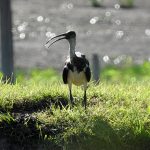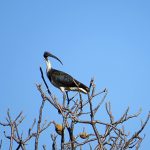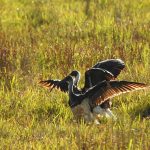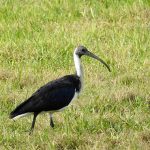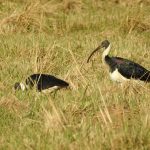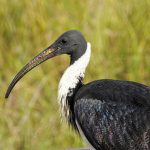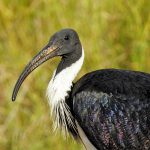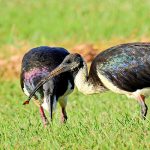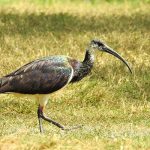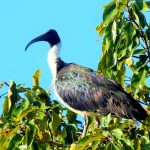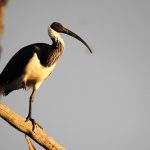STRAW-NECKED IBIS
The Straw-necked ibis is known for its distinctive appearance. These ibises have a distinctive, long, down-curved bill that is black in color. They are predominantly black with a glossy greenish sheen on their plumage. Their legs are long and dark, and they have webbed feet, which are adapted for wading in shallow water.
The name “Straw-necked” comes from the pale straw-colored band of feathers that encircle their neck, creating a striking contrast with the black body.
They are found in Australia, primarily in the eastern and southern parts of the country, including Tasmania. They are also found in New Guinea and some nearby islands.
Straw-necked ibises are medium-sized birds, measuring about 65-75 in length. The lifespan of Straw-necked ibises can vary depending on factors such as predation, environmental conditions, and human impacts. In the wild, these birds typically have a lifespan of around 10 to 15 years. However, some individuals have been known to live longer, reaching up to 20 years or more under favorable conditions.
Their longevity can be influenced by factors such as food availability, habitat quality, and the presence of threats like predators and human disturbances.
They are highly adaptable and can be found in a variety of habitats, including wetlands, swamps, marshes, grasslands, agricultural fields, and urban areas. They are often seen foraging in wetlands and other waterlogged areas.
Straw-necked ibises are social birds and often gather in flocks, especially during the breeding season.
They are opportunistic feeders and primarily eat insects, crustaceans, small fish, frogs, and plant matter. Their long, slender bills are well-suited for probing and capturing prey in muddy waters.
Breeding typically occurs in colonies, with nests constructed in trees, reeds, or other suitable vegetation. They lay 2-3 eggs, which are incubated by both parents. Chicks are born altricial, meaning they are born in a helpless state and require parental care.
Straw-necked ibises are known for their distinctive appearance and adaptability to a range of habitats. They play a role in controlling insect populations in wetlands and are an interesting part of the avian diversity in their range.

